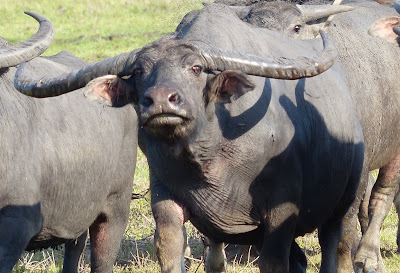Feral water buffalo have created an environmental disaster in the wetlands of the upper peninsula portion of the Northern Territory of Australia. causing soil erosion, the channeling of flood waters, an increase in the intrusion of salt water into freshwater habitats and the destruction of wetland vegetation. This has caused a decline in native populations such as crocodiles, barramundi, turtles and magpie geese.
 |
| Feral water buffalo in Australia |
Between 1825 and 1843 about 80 water buffalo, both the river type from western Asia and the swamp type with curled horns from eastern Asia, were taken to Australia for meat. Their numbers got as high as 350,000 in the 1980s, but there was extensive culling which reduced those numbers. However, the numbers have climbed back up to about 150,000.
 |
| They look quite a bit like cape buffalo. |
I was able to get a sampling of Australian feral water buffalo steaks from Exotic Meat Market: an 8 ounce striploin (long and fatty); an 8 ounce tenderloin or filet (round); and an 8 ounce ribeye. I wanted to cook them together and compare their tastes and textures.
I'd eaten water buffalo before, but it was domesticated and tasted quite a bit like beef, just a little stronger. This feral water buffalo is a wild animal and all that that entails: it is leaner, has more of a gamy taste and is tougher.
I decided to forego brining the water buffalo and decided against long cooking times to give the best indication of its natural taste and texture. I decided to cook it sous vide at 55 degrees Centigrade for 1 hour and 50 minutes.
 |
| In a sous vide pouch with butter. |
 |
| Out of the sous vide pouch. |
 |
| Briefly fried in butter. |
The ribeye was a very dark meat, had a slight liver taste, was a little gamy, very moist, and yet fairly tough.
 |
| The ribeye (left), filet (center) and striploin (right). |
The striploin was long, a little less fatty, but had a large chunk of fat along the edge. It was closer to the ribeye than the tenderloin and even the fat was chewy. I did not have a strong preference between the ribeye and the striploin.
The tenderloin or filet was markedly different. It was much more tender and less gamy. I also like the filet as my favorite part of American bison.
With this experience, I would say that the tenderloin can be cooked as-is without any special preparation, other than do not over-cook it. For both the ribeye and the striploin I recommend brining it overnight along with some acidity, such as vinegar, to break down the fibers.





Water buffalo definitely taste better than they look.
ReplyDelete